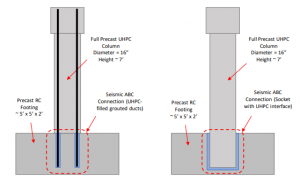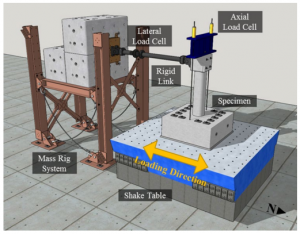Link to Latest Report: Coming Soon
Background:
It is a well-known fact that UHPC is one of the most commonly used or desired solutions for ABC connections nowadays. With more vendors entering the US market and large initiatives for developing non-proprietary UHPC mixes (e.g. ABC-UTC or PCI initiatives), the applications and use of UHPC for ABC will only continue to grow and increase. Some of the emerging applications include full structural members such as bridge girders and full columns. The FHWA is working on mega-girders that would incorporate UHPC and large prestressing strands to reach spans up to 300 ft. Meanwhile, at UNR, several projects have focused on full UHPC columns but mostly under axial loading and only few explored seismic columns. Seismic UHPC columns could provide practical solutions for important bridges in high seismic zones where low-damage designs are desired. ABC seismic connections have been also emerged but yet to be coupled with full UHPC columns. Thus, this project will fill a knowledge gap and investigate the dynamic behavior of full UHPC columns with ABC seismic connections. One or two large-scale columns will be tested at one of the shake tables at UNR under earthquake excitations. The test specimen(s) will consider a full precast UHPC column connected to a conventional reinforced concrete footing using a seismic ABC connections. Two types of connections will be explored to select the most promising one and use for the UHPC column specimens. These are the socket connection and UHPC-filled grouted ducts.
Objective:
The specific objectives of this project are to: (1) explore different ABC seismic connection options for precast UHPC columns; (2) design and construct full precast conventional concrete footing and UHPC columns to assemble test specimen(s); and (3) conduct uniaxial shake table testing for test specimen(s), i.e. full UHPC column with ABC connection, to investigate for the first time the dynamic and structural response of such application for future bridge columns.
Scope:
To accomplish the research objectives listed in the previous section, a comprehensive experimental program, that involves a total of 4 research tasks, will be conducted as outlined and discussed in this section.
TASK 1 – Literature Search A comprehensive literature review will be conducted to obtain the latest information on ABC seismic connections, UHPC structural applications, design guidelines and toolkits, etc. The main objective of this task is to synthesis the reviewed literature to select the most promising ABC seismic connection for precast UHPC columns and implement latest design guidance available for UHPC structural design.
TASK 2 – Experimental Program Development The goal of this project is to employ an experimental approach to investigate the dynamic and structural behavior of full precast UHPC columns coupled with ABC seismic column-to-footing connections. Although the final ABC connection type and design philosophy to adopt for this project will be determined based on the literature search in Task 1, yet this is expected to be one of the two common ABC seismic connections illustrated in Figure 2. This study is planning to test at least one specimen but pending what the budget and time would allow, a second specimen might be considered. In such case, two identical UHPC columns with varying ABC connections will be tested. Figure 2 provides schematic illustrations of the proposed test specimens (configuration, preliminary dimensions, etc.) and different ABC connections.

Figure 2 Schematic illustration of proposed full precast UHPC columns with two different types of ABC seismic connections to be tested at the University of Nevada, Reno The objective of this task of the experimental program development is then to finalize the design and construction of test specimen(s). Reinforcing steel will be acquired first to be carefully instrumented using strain gages. A contractor or commercial precast concrete producer will be hired to build the test specimen. The PI has already discussed this project with the Executive Director of the Precast/Prestressed Concrete Institute (PCI) West Chapter in CA and NV and in the process of lining up a professional precaster/producer to collaborate with for this project. Some of the producers to be approached include Con-Fab, CTU Precast, Kie-Con, Clark Pacific, and Jensen Precast. The goal of this sought collaboration, if successful, is to further help with implementation since actual precast concrete producers are likely to bid for future UHPC and ABC projects.
TASK 3 – Material Characterization and Shake Table Testing Once the construction of the test specimen(s) is completed in Task 2, extensive experimental testing will be pursued. First, a comprehensive set of material characterization tests of the UHPC that will be sued in the precast columns as well as ABC connections will be conducted. This will include instrumented compression tests to obtain full stress-strain behavior in addition to flexural and direct tension tests. The material characterization will be indispensable to interpret the shake table test results at later stages. Next, the test specimen(s) will be tested at one of the UNR’s shake tables in the Earthquake Engineering Laboratory under uniaxial ground motions. Various ground motions will be considered as part of finalizing the testing protocol. A schematic representation of the proposed test setup for a single column shake table test is shown in Figure 3. The PI has conducted tens of shake table tests in the past 5 years and in turn, this task is expected to be conducted smoothly with no foreseen challenges.

Figure 3. Proposed Precast UHPC column with ABC seismic connection test specimen and shake table test setup at the University of Nevada, Reno
TASK 4 – Experimental Data Processing and Interpretation The objective of this task is to carefully reduce and process the different types of data expected to be generated from the material characterization tests along with the shake table tests. The data processing and interpretation will aim at understanding the structural and dynamic response of the UHPC columns as well as ABC connection. For example, data from the dynamic tests will be used to estimate damping for UHPC columns and track the stiffness degradation, as reflected in the change in the vibration frequencies. Strain gage data will be used to track longitudinal and transverse reinforcement yielding and rupture (if any). Global force-displacement relationships and hysteretic behavior will be obtained and studied as well to determine force and moment capacities. Overall, a good understanding of the plastic hinge damage and ABC seismic connection performance will be established at the end of this task so that it can be summarized and reflected in a potential ABC guide.
TASK 5 – Results dissemination and Final report A final report will be prepared and submitted first to the advisory panel for review and comments then a revised version will be widely disseminated through the ABC-UTC. The report will be complemented with ABC-UTC guide (see section 2.2.2) for the design guidance for precast UHPC columns and ABC seismic connections. At least one journal paper is expected to be produced from this project and will be submitted for potential publication in a peer-reviewed journal.
Research Team:
Principal Investigator: Dr. Mohamed Moustafa
Co-Principal Investigator: N/A
Student Assistant: Allan Romero, Milana Cimesa

